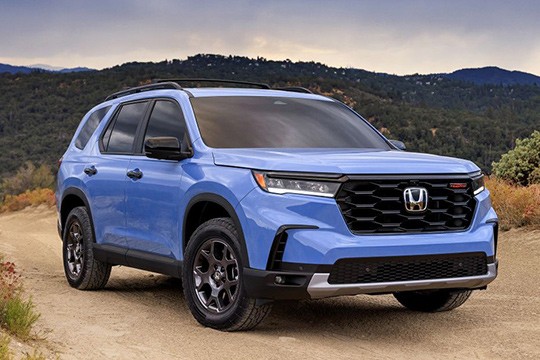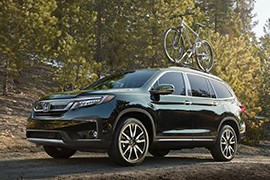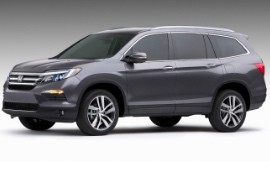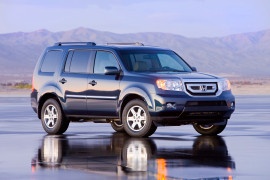HONDA Pilot Models/Series Timeline, Specifications & Photos
First production year: 2009
Engines: Gasoline
Body style: SUV (Sports Utility Vehicle)
Honda launched the fourth generation of its largest SUV, the Pilot, in 2022 for the 2023 model year, and besides the regular version, it also introduced a more rugged one that was ready for more adventurous destinations.
In just two decades, the Pilot rushed through four generations. While the first of its kind, introduced in 2002, was more of a larger CR-V, the 2023 model year introduced in 2022 was created on a truck platform. Furthermore, its exterior styling was significantly different from that of any of its predecessors and featured advanced solutions for new challenges. It was also the roomiest and finally offered an eight-seat option for the Limited trim level. In addition, the entire range received a new ten-speed automatic, a more potent engine, and a more pleasant cabin.
At the front, the 2023 Honda Pilot had a flat grille that inspired a more rugged vehicle. Its slim headlights sporting LED daytime running lights followed the design language introduced by the Civic lineup, albeit at a larger scale. The lower side of the bumper looked different depending on the grade. There, the automaker installed black inserts on the functional side scoops that flanked the lower air intake, while the Limited featured chromed ones.
Honda made the 2023 Pilot look more rugged even in the base grade, which was the Sport. However, the TrailSport grade had black trims around the wheel arches, AT tires, and black side sills that made the vehicle look like it had a higher ground clearance. The fourth generation of the Pilot also featured raked-forward C-pillars, which was uncommon for a vehicle in this segment, especially if the tailgate and D-posts were almost vertical. At the back, the SUV featured wide taillights that merged from the quarter panels onto the tailgate.
Inside, customers were pampered with heated front seats regardless of the grade. On the dashboard, the automaker placed a seven-inch touchscreen for the infotainment system that supported Apple CarPlay and Android Auto, both wired. For upper grades, Honda put a nine-inch touch-sensitive display and wireless connectivity with both operating systems. All grades were available with room for eight and a removable middle seat for the middle row, thus creating a more spacious area for those seated behind the front seats. Honda made the Pilot a proper people carrier, with plenty of room for adult-sized passengers in the rearmost row.
Honda used an evolved version of the 3.5-liter V6 engine that was previously installed in the Pilot’s third generation. Unlike that, it was paired as standard with a ten-speed automatic transmission. Customers could opt for front or all-wheel-drive, depending on the grade. The TrailSport came exclusively with a 4WD system, which allowed the vehicle to tow up to 5,000 lbs (2,268 kg).
Honda enjoyed great success with its three-row SUV Pilot and tried to keep sales figures high by refreshing the model three years after it launched the vehicle’s third generation in 2015.
By 2018, customers were already delighted by Honda’s eight-seat crossover vehicle. However, there were a few things that the Japanese automaker had to improve to keep up with the fierce competition. Even though it had to bump the prices a bit, the car still had its aces up its sleeves to convince buyers, and one of them was the excellent resale value of the vehicle. In addition, there were some significant improvements meant to make life on board easier for all seven or eight occupants, depending on the trim level.
One of the key areas that was improved was the car’s front fascia. The 2019 Honda Pilot came with new headlights that sported an angular shape, swept back on the sides, and featured LED daytime running lights on the outer edges. Another noticeable change was for the grille, which sported two chromed slats instead of three as on its predecessor. In addition, the radar for the standard Honda Sensing safety package across the range was placed behind the brand’s badge. On the lower side of the bumper, the automaker added a pair of side scoops that housed the round fog lamps, while the center air intake featured a rock-slider-like silver trim underneath it.
From its profile, there were no significant changes compared to the 2016 model year Pilot. However, the rearview mirrors with integrated turn signals were new. Its side sills were available with chromed trims on their lower sides that emphasized the offroad capabilities of the vehicle, which were adequate for vehicles in its segment. Another change was at the back, where Honda installed new taillights for the 2019 Pilot.
Inside, there was a very similar design to the non-facelifted version of the Pilot. The most obvious change was in the infotainment system. Honda was criticized for ditching the turn-volume knob on the eight-inch touchscreen placed atop the center stack. As a result, it rearranged the layout and placed the volume knob closer to the driver. Like its predecessor, the three-row SUV was available with either two seats at the front and three on the other rows. Those who opted for the Limited trim level could enjoy heated and cooled seats (available as an option). Base versions didn’t have too many things to brag about, albeit from the second grade up, the 2019 Honda Pilot was fitted with the heated steering wheel as well.
Under the hood, there were no surprises. The Japanese automaker installed a 3.5-liter V6 engine that produced 284 PS (280 hp) and paired it with a six-speed automatic. At the same time, upper grades were fitted with a reworked nine-speed automatic transmission.
Honda introduced the third generation of the Pilot in early 2015 at the Chicago Auto Show, and it was a big step forward compared to the boxy-looking second generation of this moniker.
The Japanese automaker kept the second generation of the Pilot on the market for just seven years. Still, it helped the car manufacturer overcome the challenges of the world financial crisis. In addition, it had plenty of time to listen to its customers and hear what they liked and didn’t enjoy in Honda’s three-row SUV and fixed everything. Or, at least, it worked hard on those matters. As a result, when the automaker pulled the wraps off the 2016 Honda Pilot, customers were delighted. As a result, the vehicle sold well despite being in a highly contested market segment where Toyota, Nissan, and Ford had their offers.
At the front, the automaker introduced a completely new design language for the Pilot. Instead of the previously used wedged shapes, it created smoother lines with swept-back headlights. Between them, Honda installed a three-slat grille where the brand’s badge took center stage. The upper slat was extended over the headlights, resembling a samurai sword. Lower, on the bumper, the Pilot featured a pair of side scoops that housed the blinkers and the daytime running lights, while on the apron was a second air intake.
From its profile, the 2016 Honda Pilot revealed a clear SUV stance with a short nose compared to the rest of the vehicle. However, it didn’t look like a minivan, even though it shared its GLTP2 platform with the Odyssey. The long greenhouse ended with a slightly tilted forward tailgate that sported a roof spoiler at its top. Thanks to the alloy wheels and flared wheel arches adorned by black plastic trims around them, the car looked ready to tackle unpaved roads and even some soft off-road sessions. In addition, the sculptured line below the windows created a dynamic look to the vehicle.
Inside, there was room for up to eight adults on the three rows of seats, albeit the top trim level was available exclusively in a seven-seat layout, with captain chairs in the middle. At the front, the driver fronted a dashboard that looked like it was carried over from a sedan. The redesigned instrument cluster followed the trend of mixing large displays with analog dials. As a result, the speedometer was digital, while the tachometer and the fuel and temperature gauges flanked a TFT for the car’s onboard computer. Atop the center stack, all but the base grade featured an eight-inch touchscreen for the infotainment system. At the same time, the center console housed the buttons for the automatic transmission, which was standard across the range.
Under the hood was a 3.5-liter V6 engine as the only option. On the lower grades, Honda paired it with a six-speed manual, while the top trim levels sent the power to the wheels via a nine-speed automatic. Customers could opt for either a front- or a 4WD system. While the car didn’t shine in the fuel-efficiency catalog, it was the star of the Honda SUV family.
Honda introduced the second generation of its large SUV Pilot in 2008 for the 2009 model year and surprised its customers with the boxy design look of its vehicle and interior room.
While the world financial crisis affected sales, carmakers began to shrink their costs. On the other hand, Honda understood that the market asked for more SUVs and tried to provide them with a new model to lure buyers into its showrooms. The previous generation of this nameplate looked more like a scaled-up CR-V, but the new model came with a distinct boxy appearance. Furthermore, it enhanced the vehicle’s interior and drivetrain. Honda made the Pilot based on the same platform as the Acura MDX but with seating for seven. It offered the car in five grades: LX, EX, EX-L, Touring, and SE. The last version was available only for the 2015 model year before introducing the third generation of the Pilot.
Honda created the 2009 Pilot with an unusual-looking front fascia that sported a floating-grille design, where a silver trim looked like it was suspended on the black mesh behind it. The rectangular headlights that flanked it sported round headlamps and corner-mounted turn signals. On the lower side, the Japanese automaker placed a wrapped-around plastic bumper adorned by a trapezoidal-shaped trim that mimicked a rock slider and flanked by available fog lamps.
The boxy look of the vehicle was more evident in the SUV’s profile. Its raked windshield was the only element that wasn’t vertical. In contrast, the flat side panels and windows created an image of a utility vehicle rather than a family-friendly SUV. Even the door grab handles looked like they were carried over from a truck. To further enhance the rugged look, Honda added flared wheel arches and didn’t put any side sills to emphasize ground clearance. At the back, the vertical tailgate featured an independently opening rear window, which allowed customers to easily load smaller items into the trunk. All grades came standard with a tow-hitch.
Inside, the tall dashboard didn’t resemble other Honda vehicles from the same era. Fronting the driver was a three-dial instrument panel featuring an additional display for the car’s onboard computer. Atop the center stack was a second display for the multimedia system. At the same time, a sat-nav unit with an eight-inch touchscreen was available. Honda placed the gear selector next to the steering wheel, mounted on the center stack, which was another odd solution. Those looking for an excellent sound experience could opt for the 512-watt ten-speaker audio. The Pilot came fitted as standard with seven seats in a 2-3-2 layout. With all the middle and the last rows folded, the trunk space reached a staggering 87.6 cu-ft (2,480 liters).
Under the hood, the Pilot had only one engine option, a 3.5-liter V6 that put out 253 PS (250 hp) paired with a five-speed automatic gearbox. Honda offered the option of either an FWD or a 4WD system. The latter variant could tow up to 4,500 pounds (2,041 kg.)



